
Thoughts on the Chelsea game?
“A top team has to be complete in the four moments of the game. Possession, non-possession, defensive transition, attacking transition… You can be an attacking team, you can be a less attacking team, you have to be good in every moment. That’s a basic thing.”
Manchester United vs Chelsea; a game where both sides had big problems interconnecting the various phases of play. United did win 4-0 in the end, but in the first half they had huge problems when they were not in possession of the ball.
Throughout his time at United, Solskjaer has been very flexible with his formations and system with the overall philosophy being to win the ball and release the attackers who are often in higher areas quickly. Since replacing Mourinho, Solskjaer has been looking to implement a style of play aiming to exploit the counterattacking attacking threat of the team while minimizing their vulnerabilities in possession. This approach has led to victories against Chelsea twice, a win at Arsenal and Spurs and draws against Chelsea and Liverpool since he has been at the club.
Against Chelsea in the opening game of the season, this obsession of leaving the offensive players high for quick transitions affected the dynamic of the game from a defensive standpoint for United. Rashford had an interesting role in which instead of following Azpilicueta on the overlap, he stayed forward. The intent was to get Rashford closer to Martial for combination play and a quicker route to attack in the instance Chelsea have lost the ball. However, you can say this was a risky strategy. The midfield particularly struggled when Chelsea had the ball by trying to adjust to the overloads Chelsea got on their right which led to more gaps being opened in the midfield area. Chelsea retained the ball well, made some quick switches into open spaces and dominated the beginning in terms of territory and shots.
It wouldn’t be far-fetched to describe this as a mistake given the balance of play, however we have seen in the past that this was a deliberate plan by Solskjaer to leave the forwards as high as possible and to endure the situations Chelsea could get. In the ‘big six’ games last season Solskjaer employed the same tactic of leaving his fullbacks with greater defensive responsibility in order to allow his attacking players to stay further up the pitch. In my opinion, this could be a big reason why Aaron Wan Bissaka was so heavily pursued. His physical characteristics as well as his incredible ability to anticipate and make tackles makes him a nightmare to face.
Looking at the characteristics of this United team, they do not have the make up to control games in possession in the games against the fellow big teams. Chelsea tried to make the pitch as big as possible in possession, but whenever they lost the ball it seemed they were not prepared to deal with the defensive transition. Although United appeared to be unbalanced in the defensive phase, United are a side built to capitalize on the speed of the forwards and in particular Pogba’s ability to affect the entire dynamic of United’s offense from deep. This played directly into United’s hands who statistically score the most counterattacking goals since the managerial change last season.
Wolves?
“Wolves were tough games and Wolves are a very hard team to break down. They don’t give you a lot of spaces, they can counter attack.” – Solskjaer
Wolves are totally different. The ‘top teams’ have struggled to break down Wolves with 4 combined wins last season in 12 games due to their defensive balance. The club coached by Nuno have a strong focus to what they do when they do do not have the ball. Nuno’s team are a very coordinated team in the defensive phase. The execution of their defensive shape and coordination across the phases of play will raise new questions about United’s ability to control games in possession and generate high quality chances against a compact low block defense.
Wolves play very narrow and aim to overload the midfield. The front two Jota and Jiminez using their shadows often block passing entries into the midfield when they press high up the field. Together with the central players, they form a narrow web in the middle to prevent passes centrally, forcing opposition to play through the flanks. They channel their opponents build up to the less confined spaces out wide where their wing-backs are positioned. Their ability to suffocate the ball carrier and his options out wide from the initial narrow shape is a very clear plan to improve their chances of winning possession and to limit oppositions access between the lines. Their deep block makes it extremely difficult to generate high quality chances against them. Leicester on the opening day felt this. Despite having 14 shots, Leicester finished the game with an xG of 0.59 showing how difficult it is to get good chances against this team.
Wolves, on forced their opponents to take the longest shots in the league, a feat more commonly associated with high-pressing, table-topping clubs.
How does United approach this?
Wolves present an interesting match-up for United. In general, most teams who have gone up against teams playing with a back three in England have often also changed their shape to mirror their opponents. This was the case last season when United played a back three formation consisting of Jones, Lindelof and Ashley Young as center-backs at the Molineux.
Solskjaer has proven to be quite flexible with his teams so it will be interesting to see which formation he sets his team out to start the game. The first time United played Wolves this year, which was in the cup they played a back four. United were very controlled out of possession and posed no considerable threat to Wolves back-line. Out of possession, where they excel, Wolves utilized a 5-3-2 defensive shape, with wing-backs playing on the same line as the defenders. The central midfielders Neves, Moutinho and Dendoncker in their narrow shape blocked off United’s access to their forward players in build up, with the two 8’s strictly focusing on marking out Nemanja Matic and Ander Herrera. Wolves’ compact block made the pitch very “small” out of possession.
The two sides met again with United in a completely different shape. As mentioned before, most teams tend to play with a back three when up against similar shape so it will be interesting to see if Ole goes into this game with a similar shape again. It seemed he learned his lessons from the previous game where United struggled and changed to a back three formation with central midfielders Scott McTominay and Paul Pogba sitting beside Fred, and Lingard in a free role behind Lukaku.
From the first of two meetings between the sides in which United played with the back four, it was clear Wolves were not focused on United’s center-backs when they had the ball. Wolves’ first line of pressing was mainly focused on marking the United’s midfielders and blocking passes into the midfield. Does this change with Lindelof and Maguire as the starting CB duo? It will be interesting to see if United’s CBs are afforded to same time to step into the midfield area as they were in Ole and Nuno’s first match-up. Perhaps this is a factor in a big switch United made in the following game two weeks later? A bright feature of United’s build up in that game was Young who started on the right of the center-backs moving forward from the defense and subsequently allowing Dalot to take up a higher positioning on the right flank. Wolves like to block off central spaces so it will be interesting to see if Solskjaer has something up his sleeve for combination play in the channels and out wide.
In terms of chance creation, Wolves defend as deep as any team in the league. They will look to create a compact block in midfield to prevent United from moving the ball into the forward areas. United will find it difficult to find the open spaces in transition and in the opponent’s block the way they did against Lampard’s Chelsea. Going by what I saw in preseason and the make up of the squad in general, United’s offensive strategy will be difficult against sides that defend with depth. Much of the focus in preseason was on how to press opponents in such a way that should a turnover occur United have enough men forward to capitalize in transition. Wolves should play a fairly conservative game in possession in which they do not dwell on the ball in the deeper areas for pure circulation purposes but aim their possession on trying to find their attacking players forward. With their depth in defensive phase and low-risk nature in possession, it will be interesting to see how United are able to create with smaller spaces to counterattack.
Martial has not had a run of games as a center forward for three years so it’s tough to say how he copes at 9. Both Ole and Mourinho in the past have mentioned his lack of running behind and ability to position himself in threatening areas to score ‘dirtier’ goals. It will be interesting to see how he plays with his back to goal against three center-backs and how Rashford is able to time his runs from the left in behind the defenders. Should United be the ‘protagonists’ with respect to ball possession, they must show vast improvements in their transition defense from their opening game.
This should be a very close match. Wolves are a very dangerous side when they do not have the ball. Their tactical system’s pluses pose a complete different challenge than Lampard’s Chelsea whose strategy played right into the hands of United. Against very organized deep defensive systems, strategy and tactics are very important in deciding games. Wan Bissaka and Luke Shaw will need to be very controlled on when to push forward and when to stay back facing Wolves’ offensive wingbacks. Lindelof who should play on the right side of Maguire in a back four will need to be very particular about the gaps between fullback and the center back with Jota more oriented to the channel. McTominay who is normally disciplined will be entrusted to win duels in the middle of the pitch, win tackles and quickly get the ball to the more creative players. Coming up against a very technical midfield base, he must be very disciplined in when he chooses to press because he can be easily manipulated and should United give up more space in the midfield area as they did previously, Wolves’ technical midfielders will surely exploit this situation. If United can find a balance in their offensive shape and transition into a defensive structure after possession is turned over, Wolves difficulties in carving non-set piece and open play chances will be very visible.
From a tactical point of view, it should be totally different to the Chelsea game in terms of the spaces United have, thus making it a good game to gauge the evolution of Manchester United’s offense.
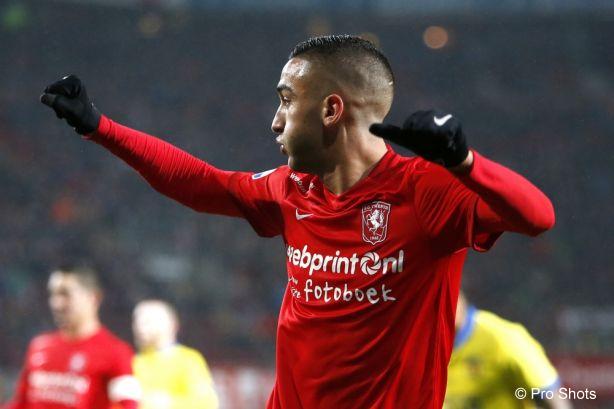
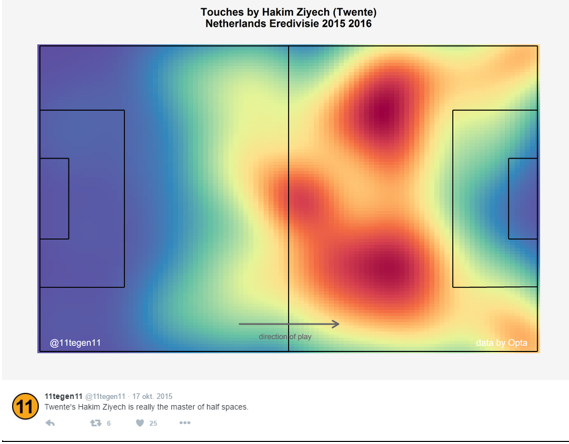

 There were caveats to Italy’s play. In terms of defensive organization and counter-pressing, the Azzurri was brilliant. In the final offensive phases however they were rather poor. That is, the creating and finishing aspect of their game was lacking. I’m looking you Candreva and all your 40 yard shots.
There were caveats to Italy’s play. In terms of defensive organization and counter-pressing, the Azzurri was brilliant. In the final offensive phases however they were rather poor. That is, the creating and finishing aspect of their game was lacking. I’m looking you Candreva and all your 40 yard shots. As seen in this Expected goals plot by
As seen in this Expected goals plot by 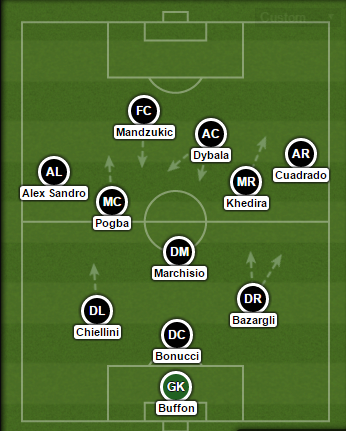
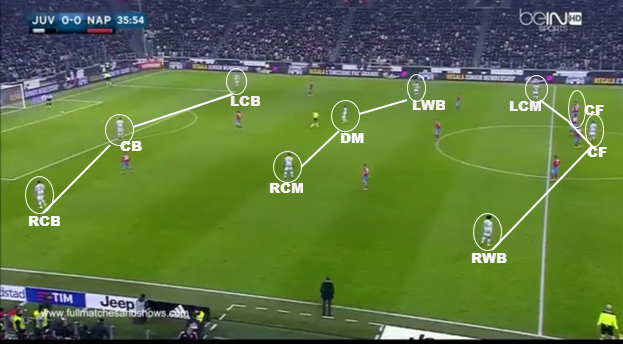 Space in football is everything. Like many big teams, Juventus often come up against deep lying defenses whose main aim is to defend their territory. In order to cleanly move the ball into the forward areas, Juventus play a very strong positional game that aims at moving the ball to move the opposition and open up spaces in the final third. The first and second phases of build up is very important to Allegri’s model.
Space in football is everything. Like many big teams, Juventus often come up against deep lying defenses whose main aim is to defend their territory. In order to cleanly move the ball into the forward areas, Juventus play a very strong positional game that aims at moving the ball to move the opposition and open up spaces in the final third. The first and second phases of build up is very important to Allegri’s model.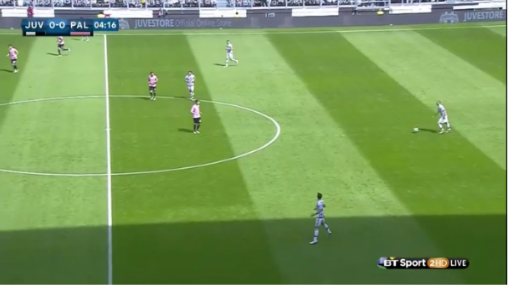 This shot captures it perfectly. As both forwards were heavily oriented on Marchisio’s access to the ball, Juventus’ back three all had time in possession to move the ball into the forward areas. Rugani and Bazargli have a lot of space to move forward and provided good diagonal angles for a pass from Bonucci. Pogba and Khedira do not contribute much directly to their deeper build up. Their actions are mainly to create space and not to receive from the centerbacks and they do so impressively. In deep build up, both Juve’s 8’s spread to the wide areas to occupy the flanks and to the halfspaces leaving a lot of space centrally.
This shot captures it perfectly. As both forwards were heavily oriented on Marchisio’s access to the ball, Juventus’ back three all had time in possession to move the ball into the forward areas. Rugani and Bazargli have a lot of space to move forward and provided good diagonal angles for a pass from Bonucci. Pogba and Khedira do not contribute much directly to their deeper build up. Their actions are mainly to create space and not to receive from the centerbacks and they do so impressively. In deep build up, both Juve’s 8’s spread to the wide areas to occupy the flanks and to the halfspaces leaving a lot of space centrally.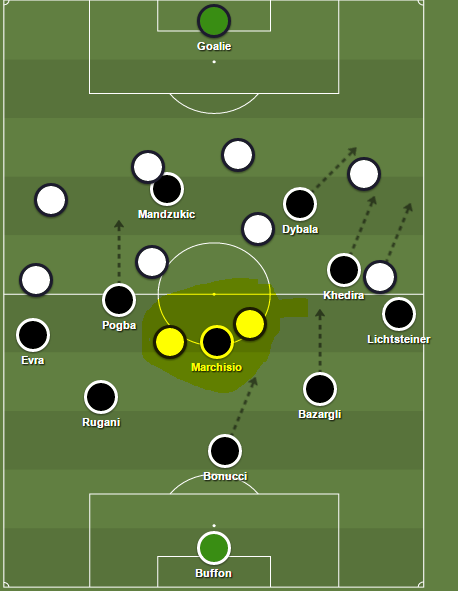 This is to pull man-oriented opposition defenses into the wider areas and create a lot of space centrally for the forwards Mandzukic and Dybala who would often drop between the lines to receive.
This is to pull man-oriented opposition defenses into the wider areas and create a lot of space centrally for the forwards Mandzukic and Dybala who would often drop between the lines to receive. Caley’s
Caley’s 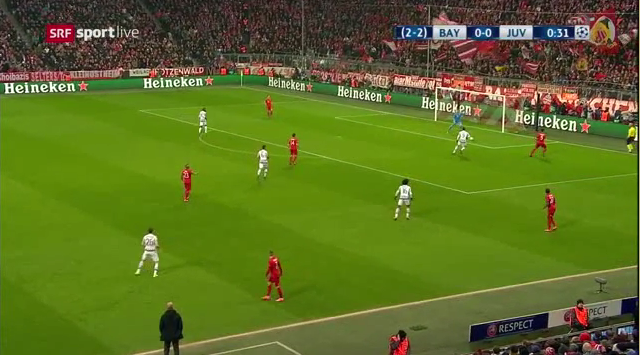 Their effective use of shadows and man-orientations disrupted Bayern’s early build up in what was one of my favourite halves of football in terms of organization. Juventus use a lot of pressing traps and have many pressing triggers. One common pressing action in their game vs Bayern was their very central positioning which opened up passing lanes to the wide Bayern players.
Their effective use of shadows and man-orientations disrupted Bayern’s early build up in what was one of my favourite halves of football in terms of organization. Juventus use a lot of pressing traps and have many pressing triggers. One common pressing action in their game vs Bayern was their very central positioning which opened up passing lanes to the wide Bayern players. 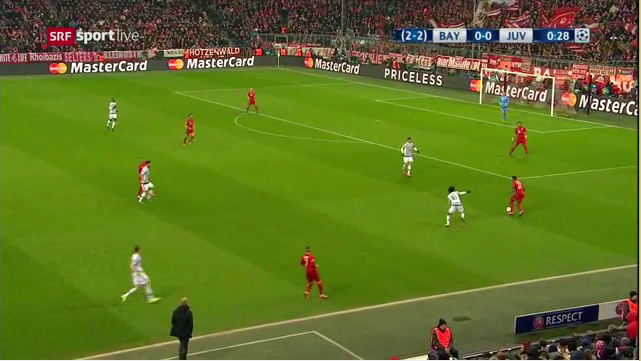 As soon as the pass is made Cuadrado in this instance on the right would sprint to Alaba in the scenario while the entire team collectively shift laterally to maintain a compact shape and cover passing options with situational man orientations. Another pressing trigger Juventus use is the sideways pass.
As soon as the pass is made Cuadrado in this instance on the right would sprint to Alaba in the scenario while the entire team collectively shift laterally to maintain a compact shape and cover passing options with situational man orientations. Another pressing trigger Juventus use is the sideways pass.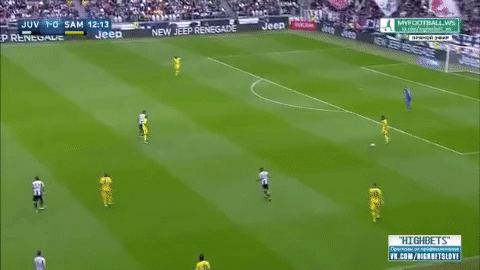 Here Juventus sit in their shape and cover vertical options into the center using the forwards. Sampdoria decide to circulate at the back and play a sideways pass from right to left. As soon as the pass is played Pogba runs to press the player in possession, the rest of the team squeeze up vertically to maintain compactness and force another sideways pass before regaining possession.
Here Juventus sit in their shape and cover vertical options into the center using the forwards. Sampdoria decide to circulate at the back and play a sideways pass from right to left. As soon as the pass is played Pogba runs to press the player in possession, the rest of the team squeeze up vertically to maintain compactness and force another sideways pass before regaining possession.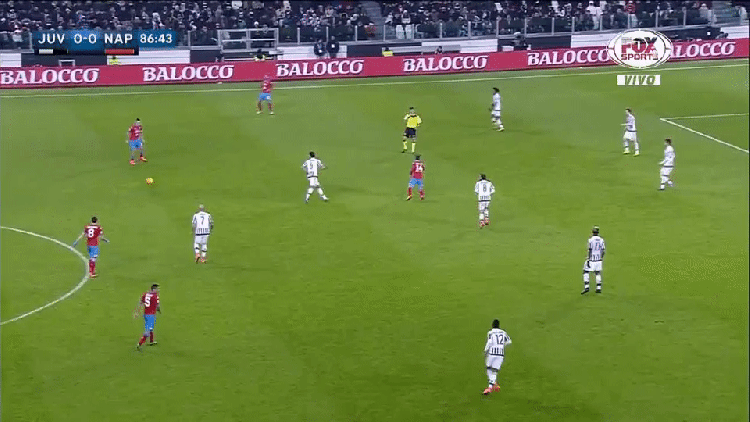 “So what’s defending? It’s a matter of how much space I must defend. If I’ve to defend the whole garden, I’m the worst defender.”
“So what’s defending? It’s a matter of how much space I must defend. If I’ve to defend the whole garden, I’m the worst defender.”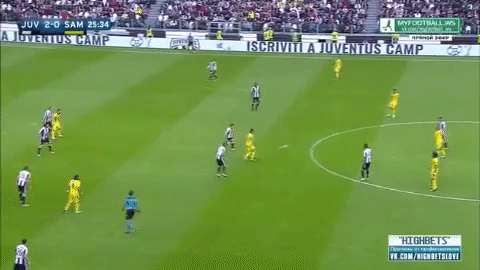 The ball-near wingback pushes high to press the ball while the far side wingback drops into the backline to make it a four-man-defense, this allows the midfield also to maintain their central position and control the middle.
The ball-near wingback pushes high to press the ball while the far side wingback drops into the backline to make it a four-man-defense, this allows the midfield also to maintain their central position and control the middle.